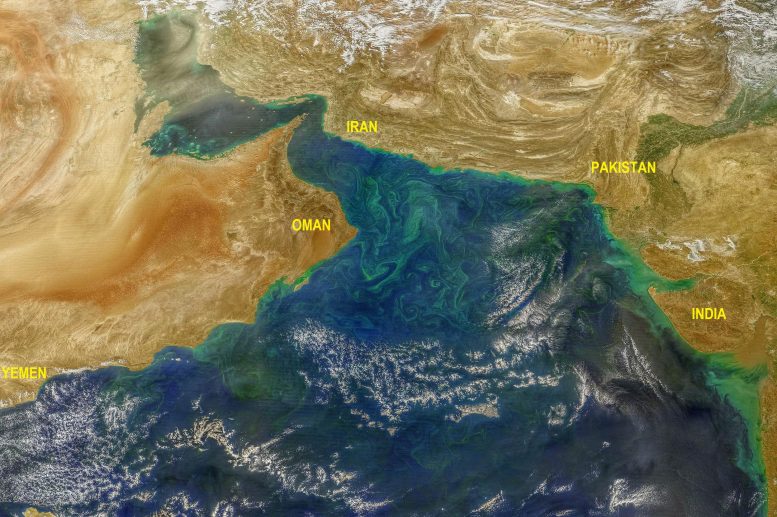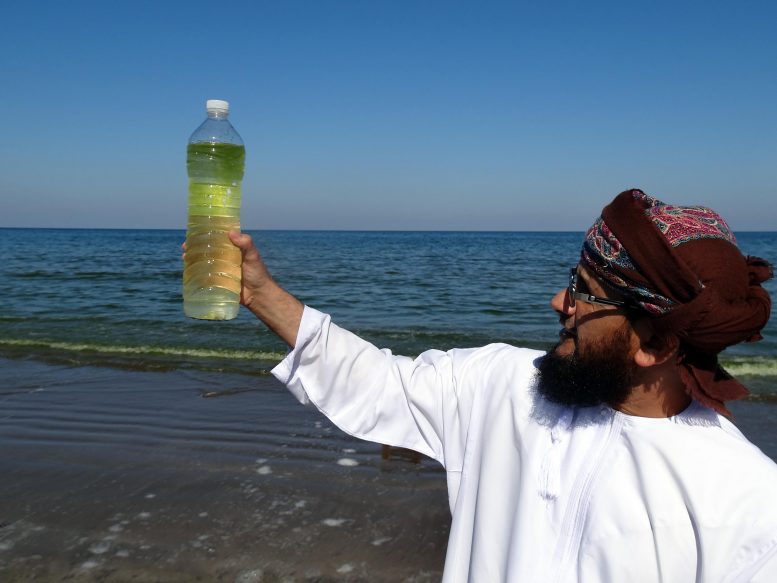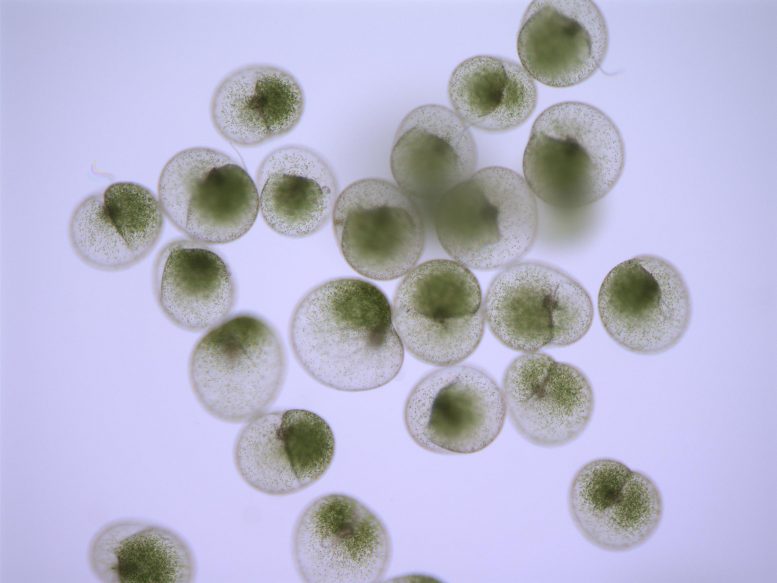
Climate-driven shifts disrupt fisheries, desalination plants; problems may hit other regions.
A uniquely resilient organism all but unheard of in the Arabian Sea 20 years ago has been proliferating and spreading at an alarming pace, forming thick, malodorous green swirls and filaments that are visible even from space. This unusual organism is Noctiluca scintillans — a millimeter-size planktonic organism with an extraordinary capacity to survive, thrive and force out diatoms, the photosynthesizing plankton that have traditionally supported the Arabian Sea food web. Noctiluca is not a preferred food for larger organisms, so these large blooms, recurring annually and lasting for several months, are disrupting the base of the region’s marine food chain, threatening fisheries that sustain 150 million people, and possibly exacerbating the rise of criminal piracy in the region.
New research published this week in Nature’s Scientific Reports describes how the continued loss of snow over the Himalayan-Tibetan Plateau region is fueling the expansion of this destructive algal bloom. Led by Joaquim I. Goes from Columbia University’s Lamont-Doherty Earth Observatory, the study uses field data, laboratory experiments, and decades of NASA satellite imagery to link the rise of Noctiluca in the Arabian Sea with melting glaciers and a weakened winter monsoon.

Normally, cold winter monsoon winds blowing from the Himalayas cool the surface of the oceans. These colder waters sink and are replaced with nutrient-rich waters from below. This convective mixing is no different than putting an ice cube into a mug of hot coffee. During this time, phytoplankton, the primary producers of the food chain, thrive in the sunlit, nutrient-rich upper layers, and surrounding countries see a bounty of fish that feed directly or indirectly on the phytoplankton. But with the shrinking of glaciers and snow cover in the Himalayas, the monsoon winds blowing offshore from land are warmer and moister, resulting in diminished convective mixing and decreased fertilization of the upper layers.
In this scenario, phytoplankton such as diatoms are at a disadvantage, but not Noctiluca. Unlike diatoms, Noctiluca (also known as sea sparkle) doesn’t rely only on sunlight and nutrients; it can also survive by eating other microorganisms. Noctiluca hosts thousands of photosynthesizing endosymbionts within its bulbous, transparent, greenhouse-like cell. The green endosymbionts provide it with energy from photosynthesis, while its tail-like flagella allows it to grab any microscopic plankton from the surrounding water as an additional source of food.

This dual mode of energy acquisition gives it a tremendous advantage to flourish and disrupt the classic food chain of the Arabian Sea. Noctiluca’s second advantage is that its endosymbionts accumulate a lot of ammonia in the cell, making the organism unpalatable to larger grazers. As a third advantage, the accumulated ammonia is also a repository of nitrogenous nutrients for the endosymbionts, making them less vulnerable to diminishing inputs of nutrients from a weakened convective mixing.
Noctiluca blooms first appeared in the late 1990s. The sheer size of their blooms, which occur annually, threaten the Arabian Sea’s already vulnerable food chain because its symbionts not only compete with phytoplankton for the annually replenished nutrients, but feed on the phytoplankton themselves. However, only jellyfish and salps seem to find Noctiluca palatable. In Oman, desalination plants, oil refineries, and natural gas plants are forced to scale down operations because they are choked by Noctiluca blooms and the jellyfish that swarm to feed on them. The resulting pressure on the marine food supply, and economic security may also have fueled the rise in piracy in countries like Yemen and Somalia.
“This is probably one of the most dramatic changes that we have seen that’s related to climate change,” said Goes who, along with Lamont researcher Helga do Rosario Gomes, has been studying the rapid rise of this organism for more than 18 years. “We are seeing Noctiluca in Southeast Asia, off the coasts of Thailand and Vietnam, and as far south as the Seychelles, and everywhere it blooms it is becoming a problem. It also harms water quality and causes a lot of fish mortality.”
The study provides compelling new evidence of the cascading impacts of global warming on the Indian monsoons, with socio-economic implications for large populations of the Indian sub-continent and the Middle East.
“Most studies related to climate change and ocean biology are focused on the polar and temperate waters, and changes in the tropics are going largely unnoticed,” said Goes.
The study highlights how tropical oceans are being disproportionately impacted, losing their biodiversity, and changing faster than conventional model predictions. This may portend dire consequences over the long term for countries in the region already gripped by socioeconomic problems from war, poverty, and loss of livelihoods, said Goes.
Reference: “Ecosystem state change in the Arabian Sea fuelled by the recent loss of snow over the Himalayan-Tibetan Plateau region” by Joaquim I. Goes, Hongzhen Tian, Helga do Rosario Gomes, O. Roger Anderson, Khalid Al-Hashmi, Sergio deRada, Hao Luo, Lubna Al-Kharusi, Adnan Al-Azri and Douglas G. Martinson, 4 May 2020, Scientific Reports.
DOI: 10.1038/s41598-020-64360-2
Lamont-Doherty scientists O. Roger Anderson, Douglas G. Martinson, and high-school students working with the observatory also contributed to the research. Other co-authors include researchers from Oman’s Ministry of Fisheries and Agricultural Wealth and Ministry of Foreign Affairs, as well as researchers from Oman’s Sultan Qaboos University, and from Tiangong and Xiamen universities in China.
The research was funded by NASA Earth Sciences, the Gordon and Betty Moore Foundation and the Sultan Qaboos Cultural Centre.
9 Comments
Is this where we believe the Science?
İt’s Persian gulf my friend.arabian sea unborn
It’s not Arabian gulf it’s Persian gulf,we(the persians) have been there for 3000years and still there
There is no such a thing as Arabian Sea!!!
Persian gulf my friend… You need to relearn geography and history.
It’s Persian gulf actually buddy
How are you gonna write an article without accurate information. So lazy
All of the people should know that it’s Persian gulf.
god website god luck